
FIRST RECORDED HISTORY – 4TH CENTURY BC
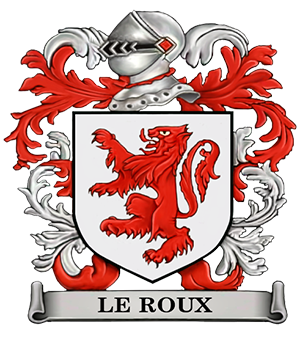
The Sovereign House of Le Roux dynasty as it is known today entered the western written history around the 4th Century BC through the reports of the Roman military commanders and through the significant role it played in Roman literature.
The "Le Roux’s", as the Romans referred to them collectively, were a tribe of noble nomadic people. They lived near the borders of the Aral Sea in what is today known as the southern part of Russia.
Their lives revolved around their flocks and herds, which grazed the rich native grasses of the region. The men and boys spent most of their waking hours as warriors on horseback, training to defend their camps from all variety of predators. Women and small children stayed close to the tribal camp. Their camp consisted of a collection of ox-carts which carried their family's possessions, and in which the family slept during stormy weathers.
The Le Roux's stood out as being tall, dark hair, fair-skinned, and in the eyes of the Roman officers looking for new recruits, a handsome and favourable group. With the records available the history of the Le Roux’s started since 305BC.
305 BC
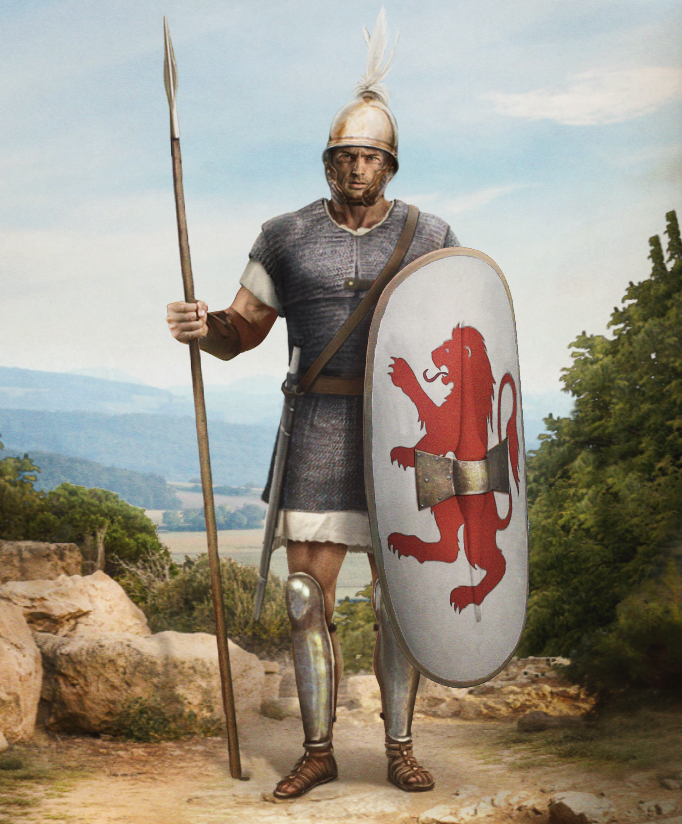
The Le Roux’s were well-known for their unique brutal fighting style; unlike that of the short bow and short sword of the typical prairieland fighter. The Le Roux’s favoured the long-wooded lance for frontal attack, and the very heavy two-handed "Barbarian" sword strapped across his back for "close work". The Le Roux warriors and their horses were heavily armoured against the light darts of their enemies. Their enemies tried to isolate and destroy individual Le Roux horsemen. However, the Le Roux’s fought more like a highly disciplined World War II tank corps, destroying everything that crossed their path. The Le Roux’s had the history and the advantage that they rarely lost any battle, but the down side was that their casualties in almost every encounter were severe. The penalty for capture was almost certainly death or life-long slavery, so the Le Roux warriors were very motivated to win. To make up for their severe casualties, the Le Roux’s typically adopted the young boys and fertile women among their captives, killing off the babies, the young females and the old or crippled, and selling the men as slaves. While the Le Roux’s could hold their own against the undisciplined tribes of the prairieland, they arranged to sell their services to the Romans as "shock troops" (Assault troops) where they were also a real match for the even more highly disciplined Roman Legions.
The surroundings and atmosphere changed permanently on the prairieland around 305-BC. The Le Roux’s grew to dominate the region, sweeping aside everything in their path. The Roman Legions took them on in a frontal assault and were immensely overpowered! But in recognition of the Le Roux fighting skills, the Romans offered to live with them, keeping their own leaders and culture, and fighting under the direction of the Romans as mercenaries’ and the elite forces. The combination of a heavily armoured Le Roux "corps" to flush the enemy out of fortified positions, and the faster, more mobile troops to pursue and capture the fleeing enemy worked very well. The Le Roux's grew so powerful and both groups prospered, at one time were even able to sack Constantinople. The Roman Empire together with the Roman Legions and the Le Roux’s followed across the Danube into central Europe, fighting as Roman mercenaries whenever the opportunity arose. It was the Le Roux’s who taught the Romans the "feigned retreat", which became their trademark and military tactic.
FROM 450 - 1400
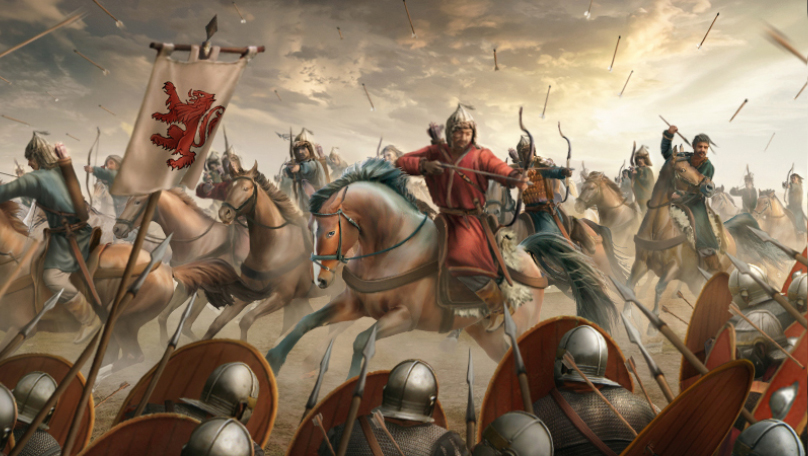
During the 450’s the Le Roux’s had partially separated themselves from the Roman Empire legions and had taken the position as rulers of Brittany. The fighting skills of the Le Roux mercenaries were the key to the two greatest victories recorded in history; against Attila in 451 at Chalon’s in France, and against Harold in 1066 at the Battle of Hastings, England. The feigned retreat is familiar to anyone who has ever played with a puppy; the idea is to pretend to be frightened and run away, enticing your adversary to follow. But as everyone who has played with a puppy knows, this strategy rarely fools anyone, particularly a trained and disciplined enemy. And when it fails, it fails disastrously. The Le Roux’s fighting forces had several characteristics in their favour. They had the reputation for slow, deliberate attacks right into the heart of the enemy's defences, taking severe casualties to achieve their goals. So, the first part of the tactic is not to arouse any suspicion. Their heavily armoured horses and men made a deliberate attempt to target as they battled to outrun their pursuers. The aim is to be completely convincing. The technique required extreme discipline from all the attacking troops; if anyone revealed the tactic too early, the enemy could simply pull aside, allowing the attacking horsemen into their midst where they could be easily isolated and slaughtered. If the attackers withdrew too soon, before they suffered severe losses, the enemy could get suspicious and simply witness their withdrawal. The Romans were taught the finer art of the technique by the Le Roux’s at a great loss of Roman troops.
In 451 the Le Roux's had their first major test against the Huns in central Asia. The Romans planned to get rid of the Huns, who had been terrorizing Western Europe and the Roman Legions. The Roman Legions were unable to stop the Huns cavalry. The Roman's planned classic power warfare. The Huns’ cavalry, led by their King Sangiban, attacked directly into Attila's camp, while the Visigoths and the Romans waited in defence of the attack. If all went as planned, Attila would leave his strengthened camp to teach his former allies a lesson, the Le Roux’s. When the Huns troops were strung out in hot pursuit, the Visigoths and the Romans would close in from both sides and massacre them, while the cavalry would turn a block off escape from the front. The Roman Legions promised the Visigoths as pay-off, (regarded as a classic Roman tactic) gold and safe passage out of France into Spain, where they would be free from Roman control.
The reward to the Le Roux’s for fighting under the Roman banner, the land to the west and north of the battle site was promised. But the Franks and Goths living on the land were not consulted, for the army that had defeated Attila would have no trouble with a few unorganized Franks. The Romans would be free of "Attila, The Scourge of God" forever, or so they hoped. The battle proceeded as planned by the Roman Legions, with one secret change. The Le Roux horsemen attacked Attila's camp, raised a major riot, and then charged back out with the Huns army in hot pursuit, exactly as they had planned. The Visigoths attacked the undefended flank of the Huns army, with severe casualties on both sides. But the Romans, in their infinite wisdom, waited quietly until the Visigoths were badly mauled before joining in the attack and finishing off Attila's trapped and the defenceless army. A few apologies and a few more sacks of gold pacified the Visigoths, who licked their wounds and made their way slowly back to Aquitaine or over the Pyrenees into Spain, a lot weaker from their recent encounter. A few carcasses of meat and local beer, and the Huns departed in peace, to occupy the land between the Romans and the Le Roux’s.
The Le Roux’s had no intention of displacing the local-residents and learning how to grow grain and grapes; instead they occupied the castles and manor houses of the local chiefs and became the local Royals and Aristocracy of Brittany. Brittany had been a semi-independent component of the Kingdom of France since Clovis I, (between 466-511) and was given authority over the Gallo-Roman domain during the 5th century. It was first recorded as a "Duchy" during the rule of Normandy in 846. Over the centuries, the fealty demonstrated by the Duchy of Brittany toward the French King depended significantly on the individuals holding the titles, as well as the involvement of the English monarchy at that particular time.
The lives of the Le Roux’s were one of training for warfare, and collecting taxes, and sampling the local alcohol supply. It was good to be a noble! The Romans gradually lost power and pulled out of France. The Le Roux’s quickly adapted to the local customs, sensing any changes on the political front and being very careful to embrace whatever new doctrine was in vogue. But for the Le Roux's these times were destined to get even better.
COUNT ALAIN FERGANT (“ALAIN LE ROUX”)
NORMAN CONQUEST WITH WILLIAM 1
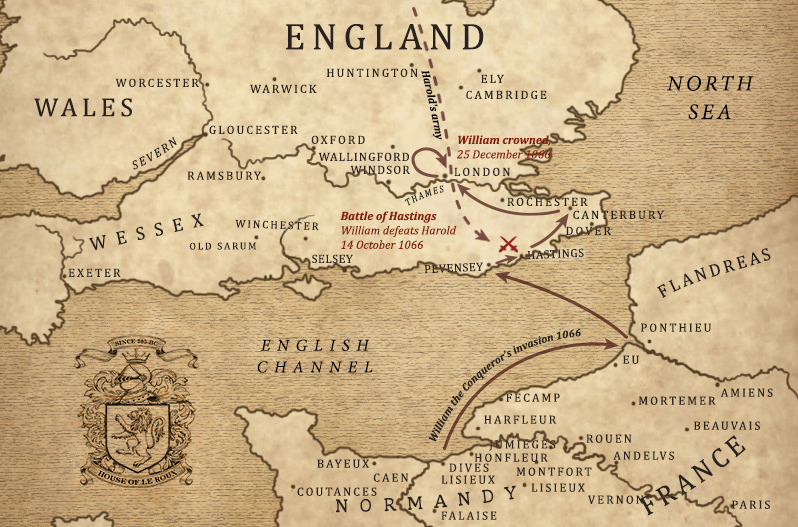
The Norman conquest of England (in Britain, often called the Norman Conquest or the Conquest) was the 11th-century invasion and occupation of England by an army of Normandy, Breton Knights, Flemish and French soldiers led by Duke William I of Normandy, later styled William the Conqueror. William, the Duke of Normandy, believed he should be the successor to Edward the Confessor. When the English crown was given, instead, to Harold II, the throne of England was vulnerable, and William, Duke of Normandy, had the most audacious plan; to invade the kingdom for himself by arranging the support of an army in southern England and defeating the indecisive King Harold. William left France and sailed to England. Within days, William landed in southern England.
He and his men encountered an undefended sea end route to England's southern coast. The plan had many parts, employing psychological warfare in conjunction with the Pope against the gullible English clergy, and using a Danish threat to northern England to divide and confuse the enemy. But in the end, William needed seasoned troops on the ground to assure his victory and offered a share of the gains to loyal supporters. The Duke of Brittany offered to finance one third of William's forces, under the command of his son, (and William's future son-in-law) Count Alain Fergant (“Alain Le Roux”).
These troops are known in the English history books as the Breton Knights, who twice at Hastings led the tactic that they are well known for, the unusual charges into the English forces, only to withdraw in panic with their enemy in fierce pursuit. Alain Fergant was present at the Battle of Hastings in October 1066. On the journey to the battle site near Hastings, the Breton Knight forces formed the vanguard, arriving a good half-hour before the rest of William's army.
Landing at the port town of Pevensey — on the 29th of September 1066—William and his men were stunned to find that England's coastline was also undefended. The English Army had marched north, to York, where they were resisting another Viking invasion (of 300 ships). Leading his troops, King Harold II prevailed at the Battle of Stamford Bridge near York (on September 25, 1066). Harold marched south to oppose him, leaving a significant portion of his army in the north. Unfortunately for the English army, this panic made the Le Roux horsemen "retreat" right between two ranks of Norman infantry and archers, where their defenceless English pursuers were massacred. The classic Le Roux "feigned retreat" worked flawlessly twice in one day, leaving Harold's forces weak and demoralized, easy prey for William's infantry. Harold's army confronted William's invaders on 14 October at the Battle of Hastings; William's force defeated Harold, who was killed in the engagement.
William left Hastings in command of the whole of England, and he rewarded his loyal supporters Alain Le Roux and his allies with Dukedoms, Earldoms, and a collection of minor titles. As it was in France 600 years earlier, the Le Roux’s (as they are known) simply moved into the castles and manor houses of the losing aristocracy took complete control of the territories, married the local beauties, adapted to the local customs and determined the flow of politics, and went back to living the good life.
WILLIAM 1 AND EARL OF BRITTANY
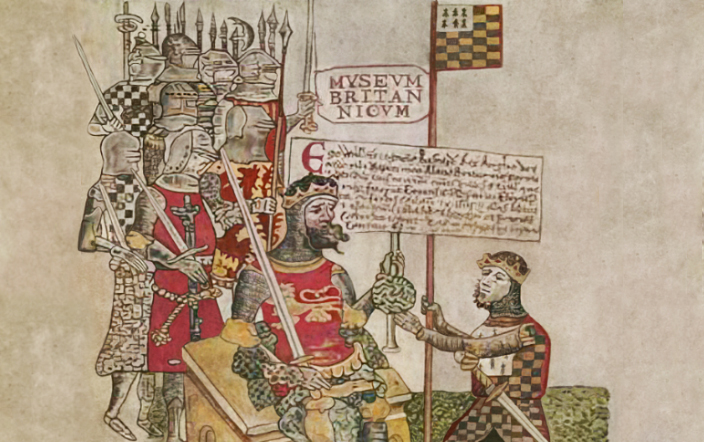
In 1067, Alain witnessed a charter of King William to the monks of St Peter's at Westminster. In January 1069, Earl Edwin in Yorkshire and his brother Earl Morcar in Northumberland rebelled. In late 1069, the King brought an army north to combat the rebels and recover York. According to the Register of Richmond, it was at the instigation of Queen Matilda, during the Siege of York, which King William conceded to Alain the Honour of Richmond (the Hundred of the "Land of Count Alain") in North Yorkshire. Unusually, within the land of Count Alain, King William himself and his half-brother Robert, Count of Mortain received only one manor each: William sharing one with Alain at Ainderby Steeple, on the eastern fringe of the Land, while Robert held one on its southern edge. The wording of the proclamation is:
Alain was among the first four magnates to support William I of England against the Rebellion of 1088 in favour of the Duke of Normandy, Robert Curthose. The uprising was led by the recently freed Odo, Earl of Kent, Bishop of Bayeux, and joined by several major magnates. Beginning in March 1088, Alain was granted additional territory by King William from the confiscated lands of his neighbours who had rebelled.
RICHMOND CASTLE
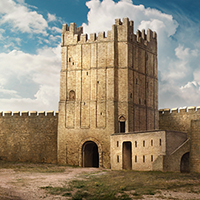
Richmond Castle was built in the aftermath of the Norman Conquest of 1066, and stands in a commanding position above the River Swale, close to the centre of the town of Richmond. In 1069 William the Conqueror had put down a rebellion at York which was followed by his "harrying of the North" - an act of ethnic cleansing which depopulated large areas for a generation or more. As a further punishment, he divided up the lands of north Yorkshire among his most loyal followers. Alain Rufus, of Brittany, received the borough of Richmond and began constructing the castle to defend against further rebellions and to establish a personal power base. His holdings, called the Honour of Richmond, covered parts of eight counties and amounted to one of the most extensive Norman estates in England. The Duke of Brittany became the owners of the castle as Earl of Richmond though it was often confiscated for various periods by English Kings.
TITLES AND LAND IN ALDINGTON
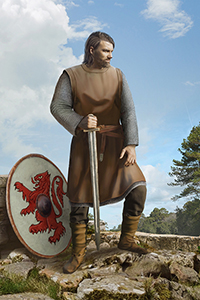
Alfred the Great was King of Wessex from 871 to c. 886 and King of the Anglo-Saxons from c. 886 to 899. Alfred was the youngest son of King Æthelwulf of Wessex. His father died when he was young and three of Alfred's brothers reigned in turn. Alfred was looking for the support of the Le Roux’s against a possible attack from the Vikings and in exchange they were offered Barony Titles and land in Aldington part of the Kent territory in 871 with the creation of the English Monarchy with Alfred the Great.
CASTLE OF HUNAUDAYE
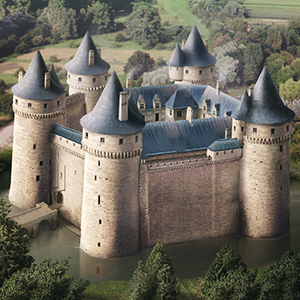
The Kingdom of France since Clovis I, (between 466-511) has given authority to the Le Roux’s over the Gallo-Roman domain during the 5th century which included the territory of the Hunaudaye Castle. This medieval fortified castle rebuilt by Olivier Tournemine in 1220, a former Gallo-roman setting at the edge of the Forest of La Hunaudaye. Located at the border of Penthièvre and the county of Dinan, this imposing castle pointed out the power of the Duke of Brittany and Tournemine as trusty servants of the Duchy. The castle was destroyed in 1341, during the war of Brittany Succession, a civil war that ravaged the Brittany dukedom during two decades. Between 1367 and 1474 Hunaudaye Castle was rebuilt. It was built as a castle with an irregular pentagonal plan, 5 round towers connected by curtain walls, a drawbridge and a surrounding moat. During the 20th century and early 21st century the castle underwent several restoration campaigns; some parts were rebuilt, and the moat was dug out again. The French government tried to save the castle by classing it as a historical monument and by buying it out in 1930. Since 1977, the Castle has been managed, maintained and developed by the Association of the Château de la Hunaudaye, which is supported by the local communities. The State and its partners grouped together to finance the restoration, which is now complete.
GRANTING OF THE BARONY OF RENDA AND PRINCIPALITY OF BELLAPRIMA
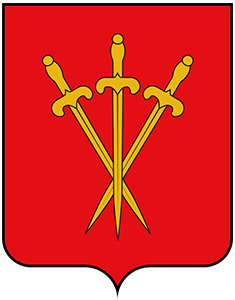
The origins of the Le Roux family bloodline are found in Caltagirone, a town located in the Catania region, in the south-eastern sector of the island of Sicily.
Originally from lineages based in Spain and Northern Italy, they settled in Palermo and Catania, on the occasion of the Aragonese conquest of the island, later moving to Mineo. The interest of the Kings of Aragon for Sicily already existed from old and derived from the marriage that Peter III, King of Aragon and Valencia, contracted in 1262 with Constance II of Sicily, daughter of Manfred von Hohenstaufen, King of Sicily, son of Holy Roman Emperor Frederick II. The Le Roux’s were granted the title of Baron de Renda.by a Royal Privilege.
The family owned several fiefs in Sicily and developed over the centuries a long history of services in favour of the Kingdom and, therefore, of the Crown of Spain, mainly in the armies and in the administration of the Kingdom, especially at a time when the French planned the conquest of the island.
During the seventeenth century, the Le Roux’s continued to increase the family’s patrimony by feuding and serving the Spanish Monarchy, being one of the most recognized noble families of the Catania and Sicily region.
The Baron & Baroness of Renda titles in Northern Italy that date back to 1262 with King Constance II of Sicily. The Prince and Princess of the Principality of Bellaprima titles that were granted by a Royal Privilege in March 1710 by Philip V of Sicily and executed the same year. Philip V of Sicily, reigned in Spain as Felipe V and was the first Spanish Sovereign of the Bourbon Dynasty, which still reigns in Spain today.
FROM 1400 - CURRENT
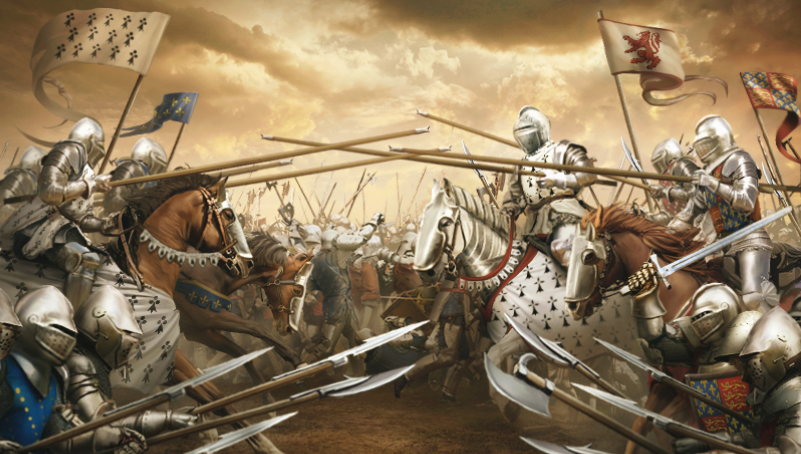
The War of the Breton Succession was a conflict between the Counts of Blois and the House of Montfort of Brittany for control over the Duchy of Brittany. It was fought between 1341 and 1364. The war formed an integral part of the early Hundred Years War due to the involvement of the French and English governments in the conflict; the French supported the Count of Blois and the Duchy of Brittany (female heir) whilst the English backed Montfort (male heir). The rival kings supported the duke of the principle opposite to their own claims to the French throne—the Plantagenet having claimed it by female succession, and the Valois by male succession. From a legal point of view, Blois had the superior claim, since Brittany allowed succession in the female line. Although Montfort was ultimately successful following the Battle of Auray in 1364, it was the French throne who gained the most from the victory.
The Le Roux’s fled from Brittany to the Netherlands for protection and received protection from the throne and received the opportunity to establish themselves in Europe and South Africa. During the period of 1500 to the 1950’s the Le Roux’s have grown very powerful and were the leaders in industries such as wine, tobacco and ostrich feathers. In South Africa the Le Roux’s became a major threat to the South African apartheid government and openly did not agree with their approach. During the 1930’s to 1940’s the ostrich feather market crashed and before the Le Roux’s could redirect funds from Europe to South Africa to supplement the losses, the South African apartheid government stepped in and seized assets. The assets were never sold on public auction but mysteriously found themselves in the hands of those who most supported the government at that time.
In 1948 the Le Roux’s again had to withdraw from business and leave South Africa back to Europe and some of the family had found isolation for protection. The Le Roux’s relied on the European structure to re-establish the family position and has started to grow again. The House of Le Roux to this day remained extremely private and confidential and focuses on business to support struggling and growing economies.
During the 1800's to the early 1900’s the family maximised on opportunities to expand its worldwide business operations and have benefited highly from the industrial struggle during the Great Depression. While most economies fell by 25% during 1918 to 1921 and did not recover until the end of the Great Depression, the family have expanded its footprint worldwide substantially.
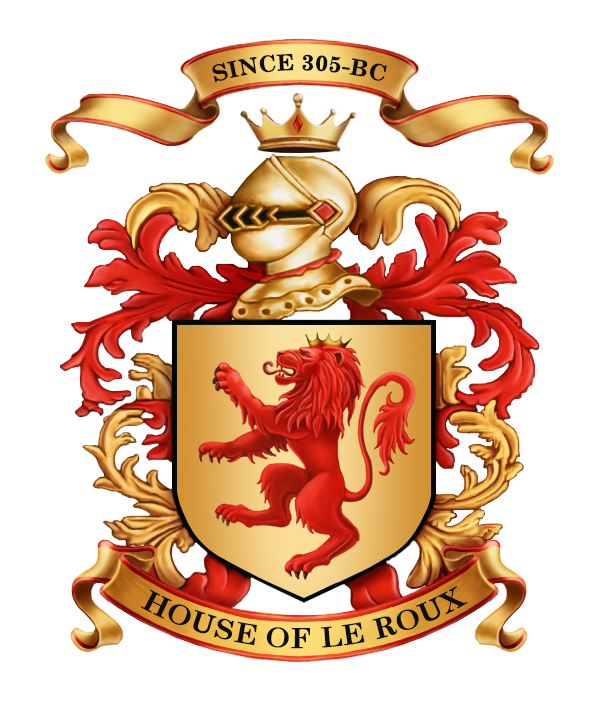
The family has maximized on opportunities to grow its business operations worldwide during most of the financial instability which preceded and accompanied by the Great Depression. Many of the European countries accumulated debt to pay for their involvement in the First World War. The large debt destabilized many European economies as they tried to rebuild during the 1920’s. With the associations and involvement of many royal families this was a great opportunity to maximize and grow its worldwide operations.
The family has expanded its business empire since the late 1920’s and has grown from strength to strength. Today the family manage its worldwide business operations via various multinational corporation and prides itself in excellence but yet remain extremely private and confidential.

 HISTORY
HISTORY 